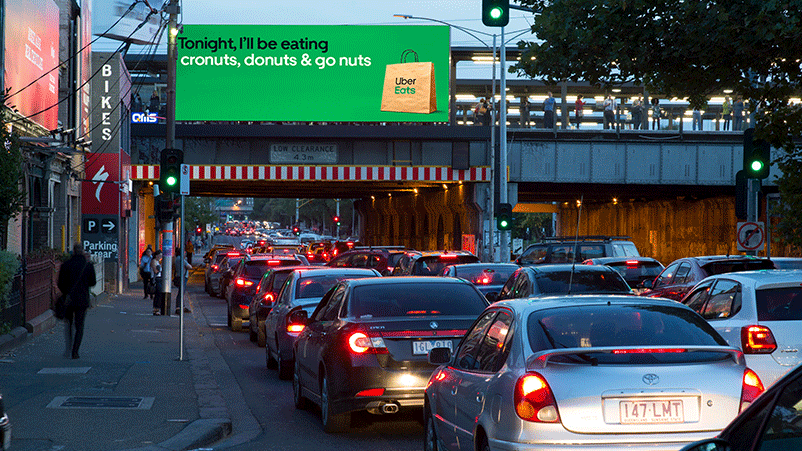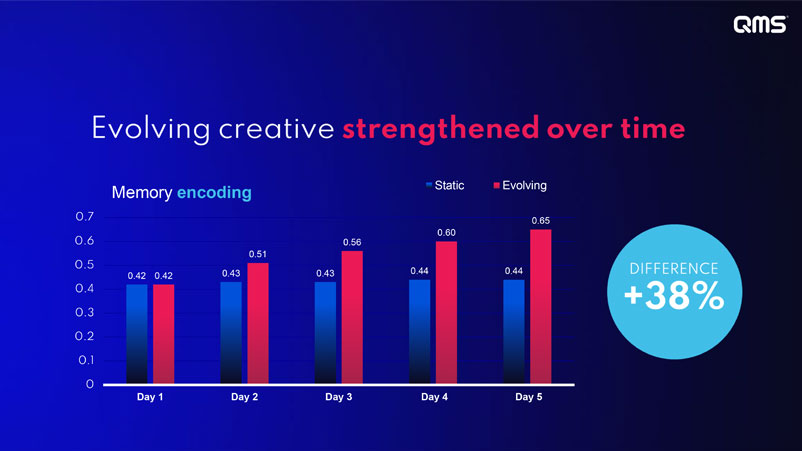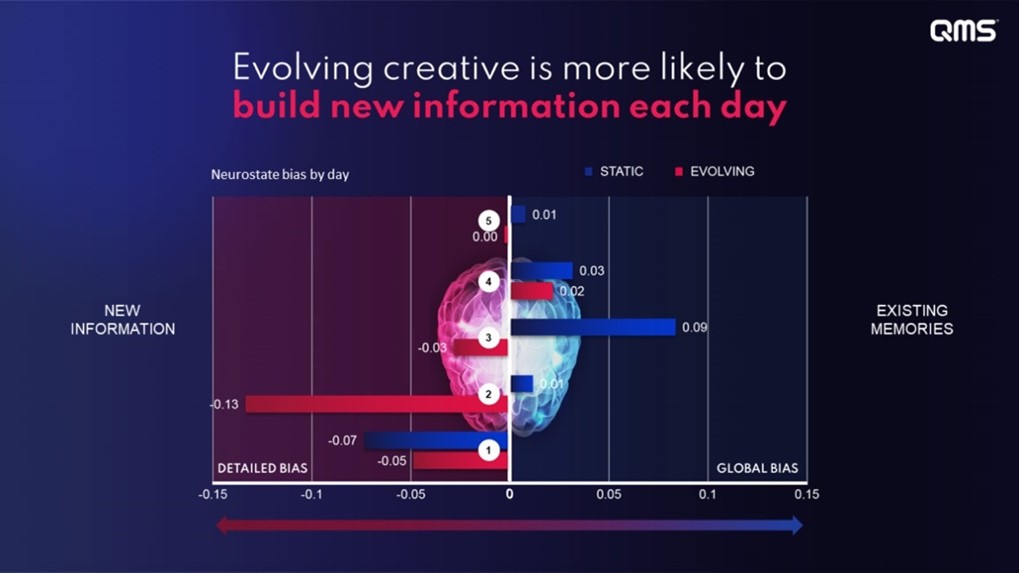How subtle tweaks to digital Out of Home creative can boost effectiveness by 38 per cent

A key question advertisers must always keep asking is, ‘where can I find a real competitive advantage?’
Even slight tweaks to creative can mean a significant boost to how successful an OOH campaign can be. That approach taps left brain bias – and actually it’s the smallest subtle tweaks that deliver the best results, according to a major neuroscience study by QMS and Neuro-Insight.
The competitive advantage hidden in plain sight
A key question advertisers must always keep asking is, ‘where can I find a real competitive advantage?’ There are a lot of strategies and ideas out there, but we now have one that had never previously been quantified: evolving creative.
We have never properly studied how a campaign is laid down into memory over a natural period of time – over a typical week, for example. But this is exactly what the Creative Evolution of Digital Out of Home (DOOH) study we have just unveiled with QMS has explored. Two huge factors – media and message – can be synchronised to significantly boost ad effectiveness. The media capabilities are in play, the scalable solutions are available, and now the evidence proves the business case to do things ever so differently.
Communications CX
Not only is the upside significant, but the lessons are even more profound. They get us really thinking about how consumers experience campaigns. We ask ourselves – How should campaigns be broadcast as reach and frequency builds? What is relevant frequency? It turns out that a great campaign is rarely ever a ‘set & forget’ investment – but a dynamic, changing, evolving consumer experience.
We’d like to take you behind the scenes on this story. When a medium, a message and a moment come together – not just once, but five times – over a typical week,
examining the very nature of our receptivity and what we are prepared or willing to let walk through the doorway to memory.
How the study worked
In this study, we compared digital OOH and static creative over time. We established consumer panels and measured the ‘sequential’ (day-by-day brain responses of a typical group of daily commuters over a week). The findings were conclusive. Campaigns that featured ‘evolving characteristics’ increased in memory encoding over the five days, whereas static creative remained at a similar level from day one to five. Evolving creative strengthened in performance each day, increasing to a 38% difference in memory encoding by day five. That’s a significant boost.

Campaigns that featured ‘evolving characteristics’ increased in memory encoding over the five days.
Christian Zavecz, QMS’ Chief Strategy Officer, summed it up. “Now we have the proof that incorporating creative evolution drives a significant uplift in OOH effectiveness. These findings should finally provide the catalyst for change on the importance placed on DOOH and how marketers will ensure their campaigns will be executed in the future.”
What’s going on here?
Different media contexts have different ways of activating brain activity. The main way this is measured is through a left or right brain processing bias – known as The NeurostateTM. Interestingly, the study revealed a difference in how the brain processes the ads using evolving and static creatives. As the campaigns ran, evolving creative showed a left (detailed) brain bias, whereas static creative favoured a right (global) brain bias.
This reveals a great deal about how we process messages over time. The DOOH that carried changing creative meant adding new information. Static OOH, on the other hand, involved activation of existing, familiar information. These are fundamentally different communications outcomes– learn more vs remind! This major finding suggests that evolving creatives have a greater ability to convey new information and can help add layers to your campaign.

Finding suggests that evolving creatives have a greater ability to convey new information.
Thinking about memory
The brain is clearly highly specialised and selective about what it allows to become a memory. As consumers experience the world around them, a lot gets filtered out and only the most relevant information gets in – most of it automatically and subconsciously.
So why are evolving campaigns more likely to enter memory? Essentially, every single exposure sets up the next exposure. If this next exposure has the right balance of familiarity and freshness, then it is met by a more experienced brain with an ‘open-door policy’ for your campaigns’ ‘new news’. It’s respecting the consumer with a degree of novelty, which is rewarded with 38% more effectiveness by day 5. .
How the creative works
Creatively speaking, if neuro has taught us anything it’s that small things can make a huge difference in effectiveness. There is an enormous power to creativity itself. Small tweaks can become significant returns.
While there are no formulas to creativity, the common thread among the best performing (individual) evolving campaigns were the ones where very little was changed. It’s really quite amazing!
Tom Donald, Head of Strategy at The Royals puts it like this: “The most effective campaigns barely change at all. They evolve and they iterate and they tweak.”
He continued: “One of the most interesting nuggets from this study is: You can change stuff – but make them tiny… because we all know that memory structures take a long time to build, so you just don’t go throwing them away. This reiterates our approach of starting with codes and distinctive assets, but then adding small moments of surprise and delight by making small and not big changes.”
Ultimately, it doesn’t take a lot to gain a lot! An effective communications strategy can be brought to life in an audience’s memory by simply evolving DOOH. Finally, media, message and moment collide!
